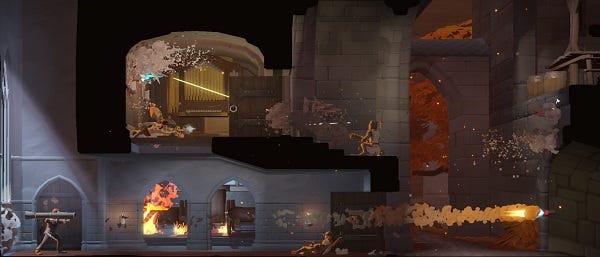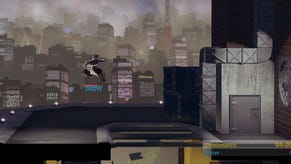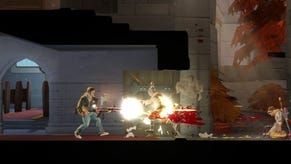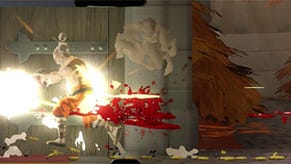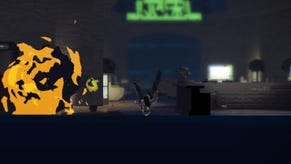Hands On: The Showdown Effect
It's dangerous to go Stallone, take Plissken
The Showdown Effect stood out at the Paradox Convention. Among the fine Port*, maps and history, here was a game that threatened to introduce itself like a shot of Tabasco sauce to the back of the throat. GUNS! ONE LINERS! SWORDS! BLOOD! ACTION MOVIES! THE EIGHTIES! I was braced for impact but as the sauce settled, I paused to swirl it around my mouth, nodded appreciatively and then turned a man's head into a blood pudding by liberally applying a fire extinguisher to his face. There are explosions and gibs aplenty, but between the bullets and blades, there's a great deal of precision.
The Showdown Effect is terribly irresponsible. It’s not the scattered limbs that an explosion will send bouncing around the level - those teach that actions have consequences - and nor is it the fact that its world is one centred entirely around violence, a series of messy massacres without purpose or prologue. Almost everything scattered around the game’s levels can be used to kill opponents and allies alike, and that’s an important life lesson with so many accidents happening in the home, but here’s the problem: a pillow will stop bullets. That’s just silly.
Yes, The Showdown Effect, is silly. It’s often gloriously silly, causing jovial cursing and disbelieving laughter as another round ends in defeat following a frying pan to the face or sword to the gut. The short time I spent shooting and slashing didn’t inspire the same sort of glee that Magicka has always been able to tease from me but I don’t think that’s the intended effect of this particularly Showdown.
While there is genuine wit in the movie send-ups that Arrowhead have clothed their game in, the actual experience of playing demands far more precision than I’d expected. While it’s certainly possible to run around like a soon-to-be headless chicken, firing and fleeing as the rapidly-changing situation appears to demand, even in a brief session it becomes obvious which players are mastering the controls and the flow.
The levels are small but with enough room for chases to be valid and the best pursuit is often a bluff, a darting out of line of sight followed by a pounce and a pummelling. Alongside the split second carnage, mindgames emerge. Of the two levels we were shown, the Neo Tokyo city structures were the most immediately appealing, purely because there’s a left to lure opponents toward. Hop in and your character rides up to the next floor and can then dive out of a window, back to a point next to the lift’s entrance, and slaughter the person who was pursuing a moment ago. Often, a character that appears to be fleeing is bait skewered on its own hook, ready to eliminate anyone foolish enough to bite.
Videos had led me to expect an ultra-gory Smash Bros, with weapons galore, and chaos rewarded more than cunning, but that’s not entirely the case. Arrowhead do cite Nintendo’s franchise as an inspiration but they also namecheck Goldeneye and there’s more of the deathmatch than the bewildering beat ‘em up in The Showdown Effect. While learning the layout of each level most likely won’t be as important as in Quake, the need for a rapid, steady aim and precise timing lends a more competitive edge to the game than the madcap styling might suggest.
Much of the skill lies in understanding the benefits of melee and ranged weaponry, knowing when to switch between them, and mastering individual weapons. I didn’t expect to notice the difference between a sword and an axe, except perhaps that one would cleave corpses into different configurations, but the former is a speedy, flashy, stabby blender and the latter takes half a second to heft. That may not seem important but death is rarely more than a breath away.
Guns require aiming, activated by holding down the right mouse button, and running, aiming, dodging, jumping and blocking – all at the same time - is tricky. Behind the irreverence, there is a game of skill that does not only have its decade of choice in common with Hotline Miami.
I spoke with Arrowhead CEO Johan Pilestedt shortly after playing a few rounds, including some team elimination in which I quickly found that team killing is, as expected, a very real possibility. It’s fair to say that we were both surprised by how much time we spent discussing boardgames and I’ll share the full transcript of that conversation in the very near future, but one of Pilestedt’s statements is worth repeating now: “A game for everybody is a game for nobody.” It’s not a stunningly original sentiment but given The Showdown Effect’s influences and the nostalgic appeal of its movie pastiche, the game does seem primed to appeal to a wide base. The nonstop violence and ludicrous comedic excess are crowd-pleasing but the game underneath the gloss, at first meeting, is more delicately poised than expected.
That said, I did spend quite a lot of time diving on top of people and then running away, without shooting them, without stabbing them and without winning any points for my team. I did it because it felt like the right thing to do and because I’m not particularly competitive. The person on the next PC craned his neck to look at my piffling score at the end of one round and then pointed at his own kill total proudly. Who had the higher ‘chortle’ count though? Which one of us could say that we had accidentally thrown a shotgun into the face of an onrushing gentleman with metal legs and a stained McClane vest? That was all mine.
There are jokes and nervous smiles about Magicka’s buggy release, but Arrowhead haven’t allowed the acclaim to blanket concerns. The Showdown Effect needs to be stable and fluid because the nature of its tight deathmatches demands it. I’ll be playing more of the beta this week – it’s available to people who have pre-ordered – but everything seems solid at first impression. Playing against the wider, scattered population will be the real test though.
Content is a different matter. There is more to come and Magicka certainly received plenty of DLC, but the brevity of the sprees cries out for variety. Character customisation is fun, with several surprisingly varied stereotypes to pick from and then pick apart. There are hats (always), shirts and trousers, although some of the trousers are actually legs and some of the hats may well be hairdos or heads. I entered one round in which everyone had picked the ‘last day on the job’ cop but even with the few options present in the build we played, each avatar was distinct. Weapons can be selected too and success in combat provides currency with which to purchase new equipment.
The Showdown Effect has something of the cartoonish style of Mark of the Ninja and the manic pace of Smash Bros, but my perspective on its chosen perspective shifted early in the play session. When the bullets and blades are flying, the tightness of the combat has more in common with my memories of the final few seconds of an encounter in Quake deathmatch than anything that scrolls from side to side.
*there was no Port but there was 'Viking' beer.
We’ll have a full interview with Johan on the site in the next few days. The Showdown Effect is available to pre-order now, which provides beta access. It costs £7.99.
